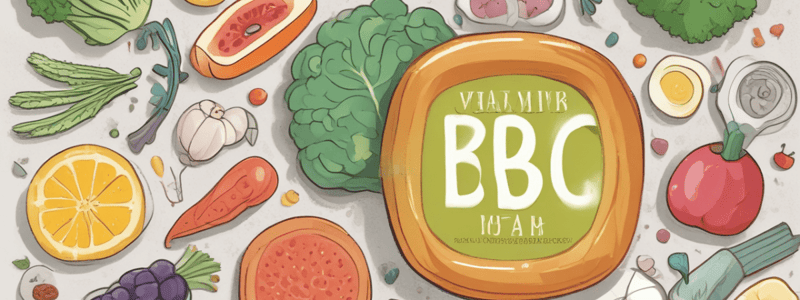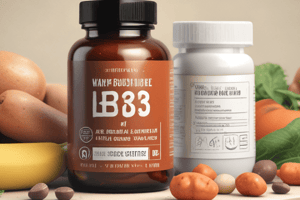Podcast
Questions and Answers
What is the primary function of micronutrients in the body?
What is the primary function of micronutrients in the body?
- To provide macronutrients
- To support growth, development, and maintenance of body tissues (correct)
- To support only major minerals
- To provide energy
Vitamin C is a macronutrient.
Vitamin C is a macronutrient.
False (B)
What is the difference between major minerals and trace minerals?
What is the difference between major minerals and trace minerals?
Major minerals are those that we need more of, while trace minerals are those that we need in smaller amounts.
Vitamin A is an essential organic substance needed in small amounts for _________________.
Vitamin A is an essential organic substance needed in small amounts for _________________.
Match the following vitamins with their classification:
Match the following vitamins with their classification:
Which of the following is NOT a function of macronutrients?
Which of the following is NOT a function of macronutrients?
Iron is a major mineral.
Iron is a major mineral.
The acceptable macronutrient distribution ratio (AMDR) is an estimate of the range of intake for each macronutrient that would allow for an adequate intake of all the other nutrients whilst ____________________.
The acceptable macronutrient distribution ratio (AMDR) is an estimate of the range of intake for each macronutrient that would allow for an adequate intake of all the other nutrients whilst ____________________.
What is a rich source of Vitamin B6 (Pyridoxine)?
What is a rich source of Vitamin B6 (Pyridoxine)?
Vitamin C (ascorbic acid) can be found in cauliflower.
Vitamin C (ascorbic acid) can be found in cauliflower.
What is a good source of Calcium?
What is a good source of Calcium?
Legumes are a rich source of the mineral ______________.
Legumes are a rich source of the mineral ______________.
Match the following vitamins with their primary food sources:
Match the following vitamins with their primary food sources:
What is a rich source of iron?
What is a rich source of iron?
Zinc can be found in wholegrains.
Zinc can be found in wholegrains.
What is a rich source of Selenium?
What is a rich source of Selenium?
Iodised ______________ is a good source of iodine.
Iodised ______________ is a good source of iodine.
What is a rich source of Phosphorus?
What is a rich source of Phosphorus?
What is the primary source of Vitamin A?
What is the primary source of Vitamin A?
Vitamin E is a water-soluble vitamin.
Vitamin E is a water-soluble vitamin.
What are the two types of vitamins based on their solubility?
What are the two types of vitamins based on their solubility?
Vitamin K can be obtained from _______________________.
Vitamin K can be obtained from _______________________.
Match the following vitamins with their sources:
Match the following vitamins with their sources:
A well-balanced and varied diet can provide all the required vitamins and minerals.
A well-balanced and varied diet can provide all the required vitamins and minerals.
How many minerals are required for metabolic function?
How many minerals are required for metabolic function?
What is the role of water in the body?
What is the role of water in the body?
Vitamins _______________________ and _______________________ are stored in the body and can be consumed through food.
Vitamins _______________________ and _______________________ are stored in the body and can be consumed through food.
What vitamin is found in grains?
What vitamin is found in grains?
Which mineral is abundant in dairy products?
Which mineral is abundant in dairy products?
What vitamin is commonly found in fruits?
What vitamin is commonly found in fruits?
Which mineral is present in legumes?
Which mineral is present in legumes?
What vitamin is found in vegetables and legumes?
What vitamin is found in vegetables and legumes?
Which vitamins are found in proteins?
Which vitamins are found in proteins?
What is a common mineral found in fruits and vegetables?
What is a common mineral found in fruits and vegetables?
Which vitamin is found in dairy products?
Which vitamin is found in dairy products?
What mineral is abundant in grains?
What mineral is abundant in grains?
Which vitamin is found in vegetables?
Which vitamin is found in vegetables?
Flashcards are hidden until you start studying
Study Notes
Vitamins and Minerals
- A well-balanced and varied diet can provide adequate amounts of vitamins and minerals.
- Fat-soluble vitamins are stored in the body and can be consumed through food.
- Water-soluble vitamins dissolve in water and are typically excreted when consumed in excess.
- There are 22 minerals necessary for metabolic function, and a deficiency in any of these can lead to physiological impairment.
Vitamin B6 (Pyridoxine)
- Found in meat, fish, poultry, liver, soy products, bananas, and potatoes.
Folate (Vitamin B9)
- Found in fortified grain products, leafy greens, legumes, seeds, liver, and Vegemite.
Vitamin B12
- Found in milk, liver, eggs, and peanuts.
Vitamin C (Ascorbic Acid)
- Found in citrus fruits, cauliflower, sprouts, broccoli, lettuce, tomatoes, potatoes, mangos, and strawberries.
Minerals
- Calcium is found in milk, cheese, yogurt, sardines, calcium-fortified soy milk, broccoli, silverbeat, kale, bok choy, legumes, almonds, and sesame seeds.
- Phosphorus is found in meat, poultry, fish, eggs, and milk.
- Magnesium is found in nuts, legumes, whole grains, dark greens, seafood, and milk.
- Iron is found in red meat, liver, kidney, heart, chicken, fish, dark greens, iron-fortified cereals, eggs, and legumes.
- Zinc is found in meat, chicken, seafood, liver, milk, whole grains, and legumes.
- Iodine is found in seafood, milk, and iodized salt.
- Selenium is found in nuts (especially Brazil nuts), seafood, liver, kidney, meat, chicken, and eggs.
Water
- Water plays several important roles in the body, including:
- Assisting in forming structures
- Filling space between cells
- Maintaining blood volume
- Transporting nutrients and oxygen
- Aiding in body secretions, digestion, and absorption
- Acting as a lubricant in joints
- Participating in metabolic processes and biochemical reactions
- Regulating temperature
- Removing waste products
- Factors affecting water intake include sex, body size, lean mass, sweat rates, environmental conditions, and physical activity.### Energy and Nutrient Requirements
- In children, pregnant women, and lactating women, the EER (Estimated Energy Requirement) includes the energy needs for tissue deposition and milk secretion for good health.
Macronutrients and Micronutrients
- Macronutrients: carbohydrates, proteins, and fats, which provide energy.
- Micronutrients: vitamins and minerals, which do not provide energy but are essential for growth, development, and maintenance of body tissues.
Vitamins
- Vitamin A
- Thiamin
- Riboflavin
- Niacin
- Vitamin B6
- Vitamin B12
- Folate
- Pantothenic acid
- Biotin
- Choline
- Vitamin C
- Vitamin D
- Vitamin E
- Vitamin K
Minerals
- Major minerals: magnesium, calcium, phosphorus, sodium, chloride, and potassium, which are needed in larger amounts.
- Trace minerals: chromium, molybdenum, iodine, selenium, fluoride, copper, manganese, zinc, and iron, which are needed in smaller amounts.
Dietary Energy
- 1 kilocalorie is equal to 4.18 kilojoules.
- The average daily energy intake from food and fluids in Australia is 8700 kJ, which is used to determine the percentage of total daily energy intake of a particular food.
- Individual daily energy intake requirements vary greatly.
Dietary Energy
- 1 kilocalorie (kcal) is equivalent to 4.18 kilojoules (kJ)
- Average daily energy intake from food and fluids in Australia is approximately 8,700 kJ
- Individual energy requirements vary greatly depending on age, gender, body size, and activity level
- During pregnancy, additional energy requirements are:
- 0 kJ/day in the 1st trimester
- 1.4 MJ/day in the 2nd trimester
- 1.9 MJ/day in the 3rd trimester
- Energy density of macronutrients:
- 1g carbohydrates = 17 kJ
- 1g proteins = 17 kJ
- 1g fats = 37 kJ
- 1g alcohol = 29 kJ
Macronutrient Distribution Ratio (AMDR)
- Protein: 15-25% of daily energy intake
- Fat: 20-35% of daily energy intake
- Carbohydrates: 45-65% of daily energy intake
- To calculate AMDR, individual's age, height, weight, and physical activity level (PAL) are required
Macronutrients, Micronutrients, and Water
- Macronutrients:
- Carbohydrates: grains, fruits, and legumes
- Proteins: proteins, dairy, and legumes
- Fats: dairy, proteins, and fats/oils
- Micronutrients (vitamins and minerals):
- Vitamins: A, C, D, E, K, and B vitamins (thiamin, riboflavin, niacin, etc.)
- Minerals: major (calcium, magnesium, phosphorus, etc.) and trace (chromium, molybdenum, etc.)
- Water:
- Human body contains 50-80% of body weight as water
- Daily water losses occur through skin and lung perspiration, urine, and faeces
- Water requirements vary depending on individual physiology
- Fruits and vegetables contain approximately 75-95% water
Additional Food Groups
- Fats and Oils:
- Contain both saturated and unsaturated fats
- Energy-dense
- Use in small amounts
- Discretionary Foods:
- Energy-dense
- Non-essential to the diet
- High in fat, salt, added sugar, and maybe alcohol
- Provide enjoyment but no nutritional value
Studying That Suits You
Use AI to generate personalized quizzes and flashcards to suit your learning preferences.


